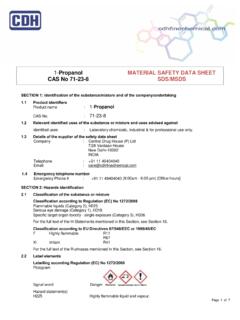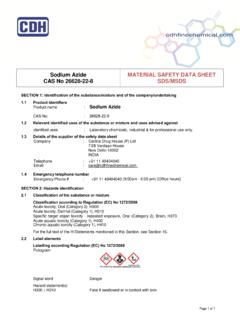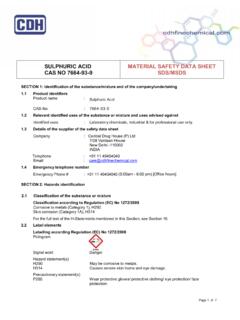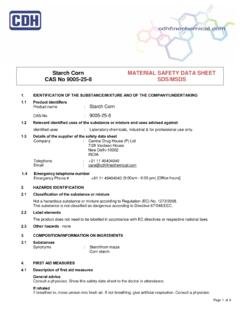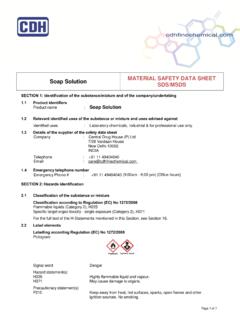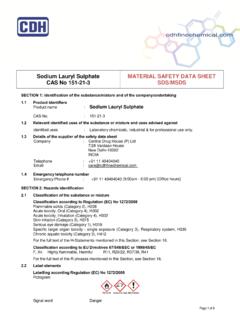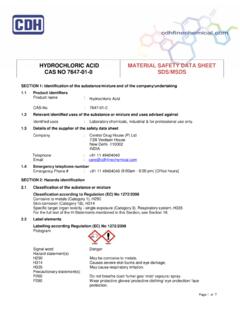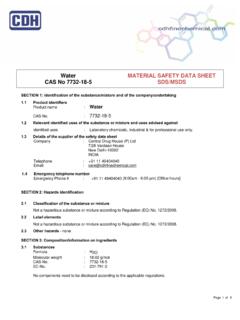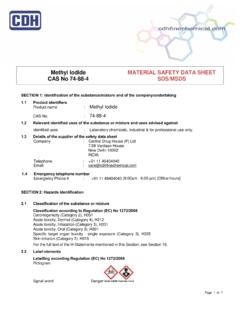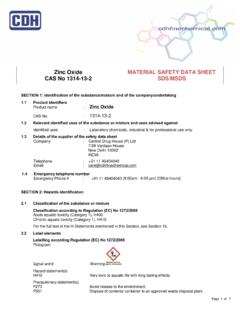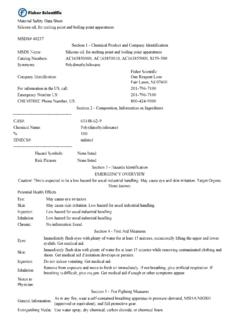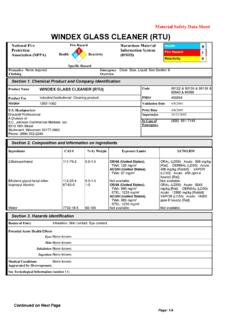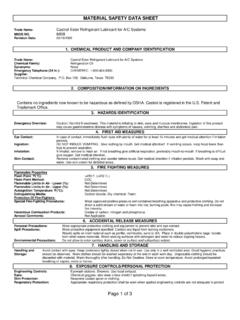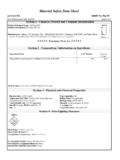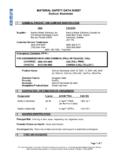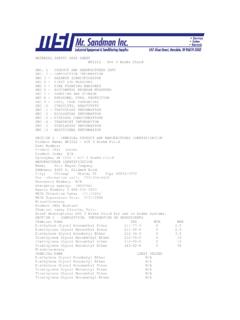Transcription of Caprolactam MATERIAL SAFETY DATA SHEET CAS …
1 SECTION 1: Identification of the substance/mixture and of the identifiersProduct name:CaprolactamCAS-No. identifieduses of the substance or mixture and uses advised againstIdentified uses:Laboratorychemicals, Industrial & for professional use of the supplier of the SAFETY data sheetCompany:Central Drug House (P) Ltd7/28 Vardaan HouseNew Delhi-10002 INDIAT elephone:+91 11 49404040(9:00am-6:00 pm) [Office hours]SECTION 2: Hazards of the substance or mixtureClassification according to Regulation (EC) No 1272/2008 Acute toxicity, Oral (Category 4), H302 Acute toxicity, Inhalation (Category 4), H332 Skin irritation (Category 2), H315 Eye irritation (Category 2), H319 Specific target organ toxicity-single exposure (Category 3), Respiratory system, H335 For the full text of the H-Statements mentioned in this Section, see Section elementsLabelling according Regulation (EC) No 1272/2008 PictogramSignal wordWarningHazard statement(s)H302 + H332 Harmful if swallowed or if inhaledH315 Causes 1 of 7 CaprolactamCAS No105-60-2 MATERIAL SAFETY data SHEETSDS/MSDSH319 Causes serious eye cause respiratory statement(s)P261 Avoid breathing + P351 + P338IF IN EYES: Rinse cautiously with water for several minutes.
2 Removecontact lenses, if present and easy to do. Continue hazardsThis substance/mixture contains no components considered to be either persistent, bioaccumulative andtoxic (PBT), or very persistent and very bioaccumulative (vPvB) at levels of or 3: Composition/information on :Aza-2-cycloheptanone2-Oxohexamethylenei mineepsilon-CaprolactamFormula:C6H11 NOMolecular g/molCAS-No.:105-60-2EC-No.:203-313-2 Index-No.:613-069-00-2 Hazardous ingredients according to Regulation (EC) No 1272/2008 ComponentClassificationConcentration Tox. 4; Skin Irrit. 2; Eye<= 100 % 2; STOT SE 3; H302, , H315, H319, H335 For the full text of the H-Statements mentioned in this Section, see Section 4:First aid of first aid measuresGeneral adviceConsult a physician. Show this SAFETY data SHEET to the doctor in inhaledIf breathed in, move person into fresh air. If not breathing, give artificial respiration.
3 Consult a case of skin contactWash off with soap and plenty of water. Consult a case of eye contactRinse thoroughly with plenty of water for at least 15 minutes and consult a swallowedNever give anything bymouth to an unconscious person. Rinse mouth with water. Consult a important symptoms and effects, both acute and delayedThe most important known symptoms and effects are described in the labelling (see section ) and/or of any immediate medical attention and special treatment neededNo data availablePage 2 of 7 SECTION 5: Firefighting mediaSuitable extinguishing mediaUse water spray, alcohol-resistant foam, dry chemical or carbon hazards arising from the substance or mixtureCarbon oxides, Nitrogen oxides (NOx) for firefightersWear self-contained breathing apparatus for firefighting if informationNo data availableSECTION 6: Accidental release precautions, protective equipment and emergency proceduresUse personal protective equipment.
4 Avoid dust formation. Avoid breathing vapours, mist or gas. Ensureadequate ventilation. Evacuate personnel to safe areas. Avoid breathing personal protection see section precautionsDo not let product enter and materials for containment and cleaning upPick up and arrange disposal without creating dust. Sweep up and shovel. Keep in suitable, closedcontainers for to other sectionsFor disposal see section 7: Handling and for safe handlingAvoid contact with skin and eyes. Avoid formation of dust and appropriate exhaust ventilation at places where dust is precautions see section for safe storage, including any incompatibilitiesStore in cool place. Keep container tightly closed in a dry and well-ventilated class (TRGS 510): Non Combustible end use(s)Apart from the uses mentioned in section no other specific uses are stipulatedSECTION 8: Exposure controls/personal controlsAppropriate engineering controlsHandle in accordance with good industrial hygiene and SAFETY practice.
5 Wash hands before breaks andatthe end of protective equipmentEye/face protectionSafety glasses with side-shields conforming to EN166 Use equipment for eye protection tested andapproved under appropriate government standards such as NIOSH (US) or EN 166(EU).Page 3 of 7 Skin protectionHandle with gloves. Gloves must be inspected prior to use. Use proper glove removal technique(without touching glove's outer surface) to avoid skin contact with this product. Dispose ofcontaminated gloves after use in accordance with applicable laws and good laboratory and dry ProtectionComplete suit protecting against chemicals, The type of protective equipment must be selectedaccording to the concentration and amount of the dangerous substance at the specific protectionFornuisance exposures use type P95 (US) or type P1 (EU EN 143) particle r (US) or type ABEKP2(EU EN 143) respirator cartridges.
6 Use respirators and components tested and approved underappropriate government standards such as NIOSH (US) or CEN (EU).Control of environmental exposureDo not let product enter 9: Physical and chemical on basic physical and chemical propertiesa) AppearanceForm: crystallineColour: colourlessb) OdourNo data availablec) Odour ThresholdNo data availabled) at 333 g/le) Melting point/freezingMelting point/range: 68-71 )Initial boiling point and136-138 C at 13 rangeg) Flash point152 C-closed cuph) Evaporation rateNo data availablei)Flammability (solid, gas) No data availablej)Upper/lowerUpper explosion limit: %(V)flammability orLower explosion limit: %(V)explosive limitsk) Vapour pressurel)Vapour densitym) Relative densityn) Water solubilityo) Partition coefficient: n-octanol/waterp) Auto-ignitiontemperatureq) Decompositiontemperaturer)Viscositys) Explosive propertiest)Oxidizing SAFETY informationBulk density7 mmHg at 60 C< mmHgat 20 CNo data g/cm3 at 75 Csolublelog Pow: at 25 CNo data availableNo data availableNo data availableNo data availableNo data g/lPage 4 of 7 SECTION 10: Stability and ReactivityNo data stabilityStable under recommended storage Possibility of hazardous reactionsNo data Conditions to Incompatible materialsStrong oxidizing agents, Strong Hazardous decomposition productsHazardous decomposition products formed under fire oxides, Nitrogen oxides (NOx)Other decomposition products-No data availableIn the event of fire: see section 5 SECTION 11: Toxicological on toxicological effectsAcute toxicityLD50 Oral-Rat-1,210 mg/kg( - Caprolactam )Remarks.
7 Sense Organs and Special Senses (Nose, Eye, Ear, and Taste): :Convulsions or effect on seizure threshold. Nutritional and Gross Metabolic:Changes in:Bodytemperature Inhalation-Rat-300 mg/m3( - Caprolactam )LC50 Inhalation-Mouse-450 mg/m3( - Caprolactam )Remarks: Behavioral:Muscle contraction or Dermal-Rat-> 2,000 mg/kg( - Caprolactam )Skin corrosion/irritationSkin-Rabbit( - Caprolactam )Result: Mild skin irritation-24 hSerious eye damage/eye irritationEyes-Rabbit( - Caprolactam )Result: Moderate eye irritation-24 hEyes-Rabbit( - Caprolactam )Result: Moderate eye irritation-24 hRespiratory or skin sensitisationGerm cell mutagenicityNo data available( - Caprolactam )CarcinogenicityThis product is or contains a component that is probably notcarcinogenic based on its IARC, ACGIH, NTP,orEPA classification.( - Caprolactam )( - Caprolactam )IARC:4-Group 4: Probably not carcinogenic to humans ( - Caprolactam )Reproductive toxicityNo data available( - Caprolactam )Page 5 of 7 Specific target organ toxicity-single exposureMay cause respiratory irritation.
8 ( - Caprolactam )Specific target organ toxicity-repeated exposureNo data availableAspiration hazardNo data available( - Caprolactam )Additional InformationRTECS: CM3675000 Convulsions, To the best of our knowledge, the chemical, physical, and toxicological properties have notbeen thoroughly investigated.( - Caprolactam )SECTION 12: Ecological to daphnia andother aquaticinvertebratesToxicity to algaeEC50-Daphnia magna (Water flea)-828-2,920 mg/l-48 h( - Caprolactam )EC50-Pseudokirchneriella subcapitata (green algae)-4,320-4,800 mg/l-72h( - Caprolactam ) and degradabilityNodata potentialNo data Mobility in soilNo data available( - Caprolactam ) of PBT and vPvB assessmentThis substance/mixture contains no components considered to be either persistent, bioaccumulative andtoxic (PBT), or very persistent and very bioaccumulative (vPvB) at levels of or adverse effectsNo data availableSECTION 13: Disposal Waste treatment methodsProductOffer surplusand non-recyclable solutions to a licensed disposal company.
9 Dissolve or mix the materialwith a combustible solvent and burn in a chem packagingDispose of as unused 6 of 7 SECTION 14: Transport UN numberADR/ UN proper shipping nameADR/RID:Not dangerous goodsIMDG:Not dangerous goodsIATA:Not dangerous Transport hazard class(es)ADR/ Packaging groupADR/ Environmental hazardsADR/RID: Special precautions for userNo data availableSECTION 15: Regulatory informationIMDG:-IATA:-IMDG:-IATA:-IMDG: -IATA:-IMDG Marine pollutant: noIATA: SAFETY , health and environmental regulations/legislation specific for the substance or mixtureThis SAFETY datasheet complies with the requirements of Regulation (EC) No. 1907 SAFETY assessmentFor this product a chemical SAFETY assessment was not carried outSECTION 16: Other informationFull text of H-Statements referred to under sections 2 and if + H332 Harmful if swallowed or if inhaledH315 Causes skin serious eye if cause respiratory Drug House (P) LtdanditsAffiliatesshallnotbeheldliablef oranydamageresultingfrom 7 of 7
